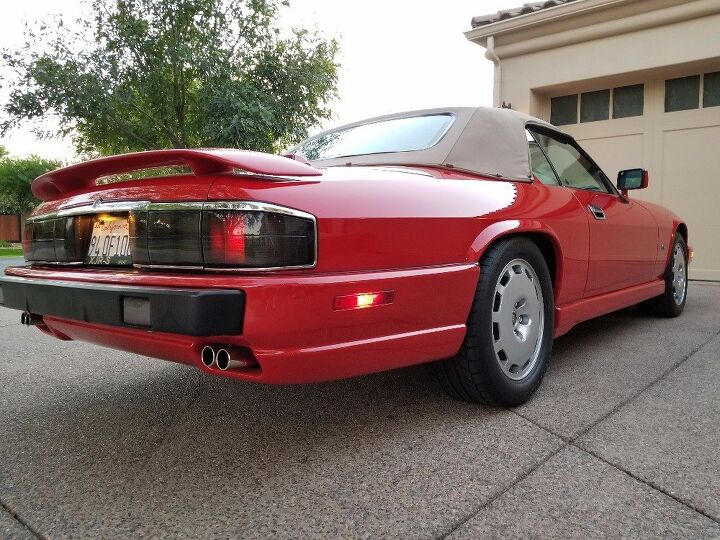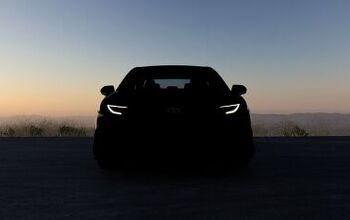Rare Rides: The 1993 Jaguar XJS, Which Is Actually an XJR… S

To celebrate the launch of a brand new model, the people at Jaguar massaged one of their longest-lived models into a special edition.
It’s the XJR you’ve never heard of.
Contrary to what one might assume (I know I did), the first R-branded Jaguar was not the XJR sedan, which debuted in 1994 on the X308 model. The XJR-S started out all the way back in 1988. Jaguar and TWR each owned 50 percent of the new company that built the coupes: JaguarSport. The first XJR-S models had the 5.3-liter H.E. (High Efficiency) V12 engine, which was not all that great. Jaguar swapped the engine for the 6.0-liter V12 in 1989.
That massive six-liter is found under hood here, as well. With a different engine management system, the XJR-S had an increased top speed: 158 miles per hour.
The XJR-S had one final year of availability in 1993, with one final special version sold only in the United States. Jaguar launched its new XJ220 supercar to much fanfare in 1992, prompting the boys in Coventry to create 100 special XJR-S examples.
Just 44 were painted in this Signal Red color, and of those, 22 were convertibles. All XJR-S models had a special body kit and unique wheel design, as well as blacked-out sport bumpers front and rear. Note the grille, devoid of chrome.
Befitting the grand touring luxury image, all XJR-S models had automatic transmissions (four speeds!), and all the walnut veneer the forest could muster.
Dashboards in late XJS models are an assortment of new and old; switches and gauges glued in wherever free space was found. Visible here is the JaguarSport special chromed sill.
This one has been well-maintained, and is still in pristine condition.
Though this was the last XJR-S you could purchase, the standard XJS would soldier on until 1996. For 1997, the XJS bowed out to the XK8, and turned over the Jaguar coupe reins it had held since 1975. For sale in Arizona, this pristine XJR-S is asking $29,900, and has more vintage character than just about any car on sale in 1993.
[Images via seller]

Interested in lots of cars and their various historical contexts. Started writing articles for TTAC in late 2016, when my first posts were QOTDs. From there I started a few new series like Rare Rides, Buy/Drive/Burn, Abandoned History, and most recently Rare Rides Icons. Operating from a home base in Cincinnati, Ohio, a relative auto journalist dead zone. Many of my articles are prompted by something I'll see on social media that sparks my interest and causes me to research. Finding articles and information from the early days of the internet and beyond that covers the little details lost to time: trim packages, color and wheel choices, interior fabrics. Beyond those, I'm fascinated by automotive industry experiments, both failures and successes. Lately I've taken an interest in AI, and generating "what if" type images for car models long dead. Reincarnating a modern Toyota Paseo, Lincoln Mark IX, or Isuzu Trooper through a text prompt is fun. Fun to post them on Twitter too, and watch people overreact. To that end, the social media I use most is Twitter, @CoreyLewis86. I also contribute pieces for Forbes Wheels and Forbes Home.
More by Corey Lewis
Latest Car Reviews
Read moreLatest Product Reviews
Read moreRecent Comments
- Jalop1991 take longer than expected.Uh-huh. Gotcha. Next step: acknowledging that the fantasies of 2020 were indeed fantasies, and "longer than expected" is 2024 code word for "not gonna happen at all".But we can't actually say that, right? It's like COVID. You remember that, don't you? That thing that was going to kill the entire planet unless you all were good little boys and girls and strapped yourself into your living room and never left, just like the government told you to do. That thing you're now completely ignoring, and will now deny publicly that you ever agreed with the government about.Take your "EV-only as of 2025" cards from 2020 and put them in the same file with your COVID shot cards.
- Jalop1991 Every state. - Alex Roy
- CanadaCraig My 2006 300C SRT8 weighs 4,100 lbs. The all-new 2024 Dodge Charge EV weighs 5,800 lbs. Would it not be fair to assume that in an accident the vehicles these new Chargers hit will suffer more damage? And perhaps kill more people?
- Akila Hello Everyone, I found your blog very informative. If you want to know more about [url=
- Michael Gallagher I agree to a certain extent but I go back to the car SUV transition. People began to buy SUVs because they were supposedly safer because of their larger size when pitted against a regular car. As more SUVs crowded the road that safety advantage began to dwindle as it became more likely to hit an equally sized SUV. Now there is no safety advantage at all.










































Comments
Join the conversation
I think a lot of us have heard of it. (Check this website's demographic projections again!)
I cringe when I see the V12. I worked on these cars to pay my way through college. To be exact, the late 70's V12 pre Michael May fireball combustion chamber design that was crafted on these old beasts to improve mileage resulting with the XJS-HE. High Efficiency in relative terms or 9 MPG vs. 13 MPG, Wow. These V12 engines cannot tolerate heat. They drop valve seats at the whiff of coolant temp of 210 F. The timing chain can shear off the cam sprockets and pull them down ripping to shreds the front of the engine and colliding 24 valves with 12 pistons. What a mayhem. The V12 is inherently in-efficient due to frictional losses and heat and a crankshaft that tries to move 12 skinny pistons and 4 ft long camshafts that twist and turn in their aluminum journals. Talking about heat, why would any designer in their right mind put the ignition module in the center of the V to bake at 350 degrees, what's wrong with placing it on the firewall or the side where the beautiful blue and pink relays are kept. I own 4 XJS's . A 1993 FHC and 3 convertibles 94 / 95 / 96. All have the straight six. 2 with AJ6 and 2 AJ16. Simple, straight forward low maintenance engines that can run forever and will tolerate heat, especially since the I-6 have the mechanical cooling fan, with a belt off the crank pulley, running the fan - what a life savior. On the other hand, a V12 owner will sit with sweaty palms watching the temp gauge in traffic and praying to Lucas or Mirelli to work their electric magic and have the temp sensor recognize the pending catastrophe and command a 5 dollar Lucas relay to fire up 2 wheezing electric fans that don't work half of the time. If Jaguar knew what they were doing, they would have offered a 1995 and 1996 XJR-S with the supercharged straight six, available in the same period XJR sedan. That engine would out perform that V12 any day of the week and it will kill it on a hot summer day. That would have been the grand finale for this tortured and polarizing vehicle that the market despised at the beginning and fell in love with it at the end. I guess i will have to build me a real XJR-S. Where the R stands for supeR-charged AJ16.